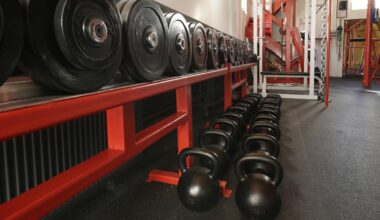The Future of Body Composition Tracking: Trends in Fitness Software
The evolution of body composition tracking is progressing rapidly, especially with the advent of advanced fitness software and applications. These solutions provide users with various methods to monitor and improve their health through accurate body measurements. Body composition focuses on components such as fat mass, muscle mass, and water levels, highlighting overall well-being. Users not only want to lose weight but also intend to gain muscle and achieve a balanced body structure. As technology advances, the integration of wearable devices and smart scales becomes essential. These devices can sync with fitness software, making health tracking seamless and straightforward. Additionally, interactive features like data visualization aid users in interpreting their progress effectively. This enhanced engagement can dramatically improve motivation and results, leading to healthier lifestyles. Varieties of apps now provide personalized insights and tailor-made workout recommendations based on individual goals. As AI continues to evolve, we can expect smarter algorithms that refine body composition tracking methods further, resulting in continuous improvement for users striving for their fitness objectives.
Emerging trends in body composition tracking are closely tied to the advancement of technology, especially artificial intelligence (AI) and machine learning (ML). Modern fitness apps increasingly incorporate these technologies into their frameworks. They analyze user data to provide personalized coaching and recommendations. By assessing past data trends, these applications can suggest optimal workout and nutrition plans tailored specifically to the individual’s physiological changes. Moreover, the predictive capabilities of AI enhance the reliability of body composition predictions across varying demographics. What typically sets apart the leading fitness apps is their ability to feature real-time feedback, allowing users to monitor their body composition with unprecedented accuracy. These apps often contain intuitive interfaces that grant easy navigation and immersive user experiences. A significant part of this development includes the integration of augmented reality (AR) technologies, where users can visualize their body changes dynamically. As fitness technology evolves, the occurrence of these innovations will likely become more prominent in everyday fitness applications, promoting healthy habits and an overall better understanding of personal health. Tracking becomes not just easier but also motivating and enlightening for users seeking meaningful outcomes with their fitness journeys.
Another important aspect of body composition tracking is the community and social elements that many fitness apps are now incorporating. Social interaction features encourage users to connect, share achievements, and offer support within a community of like-minded fitness enthusiasts. This aspect enhances engagement since users benefit from motivation and encouragement from their peers. Social features lead to healthy competition and collaborative challenges that foster personal growth. Personalized challenges tailored to individuals’ fitness levels create additional excitement and accountability. Furthermore, the role of community access enriches the tracking experience by enabling users to understand diverse strategies and approaches that others have employed successfully. Sharing progress allows for collective learning experiences, and this social interaction promotes a culture of accountability. This multifaceted approach not only helps users stay committed to their goals but extends the lifespan of fitness apps. By facilitating these digital communities, fitness software can create an environment where body composition tracking transcends individual endeavors, thus inspiring collective growth in fitness and health.This social accountability becomes a significant driver for long-term commitment.
Integrating Nutrition Tracking
Integrating nutrition tracking into body composition tracking methods is becoming increasingly essential for holistic health management. The intersection of diet and physical activity is critical to achieving optimal body composition, and many apps now offer integrated nutrition tracking features. This addition empowers users to monitor their caloric intake, macronutrient breakdown, and food quality. By doing so, individuals can make more informed dietary choices directly correlated with their body composition goals. This integration often encompasses barcode scanning features for quick food entries, as well as expansive food databases tailored to user preferences. Users gain insights into how specific foods affect their body composition over time, which in turn influences future choices. Moreover, pairing fitness and nutrition data creates a comprehensive view of overall health. Users can analyze trends, identify gaps, and make changes accordingly. The synergy of these two components eliminates guesswork and allows for more targeted interventions. Thus, expect to see more apps not only measuring body composition but also providing nutritional guidance based on empirical data from users’ dietary habits, ultimately enhancing their fitness journeys.
The significance of data privacy cannot be overstated, particularly in the realm of body composition tracking. With users storing sensitive personal health data on various applications, ensuring that this information remains secure is crucial. Fitness software providers must prioritize robust data encryption standards and compliance with privacy regulations such as GDPR. Users should be educated about how their data is being utilized, while offering transparent settings to control personal information. A proactive approach towards privacy encourages user trust and strengthens brand loyalty, essential factors in the crowded market of fitness apps. Moreover, as users become more aware of data security issues, those fitness apps that fail to address these concerns may face declining user bases. Companies leading in data protection will likely gain a competitive edge and foster a devoted user community. Ensuring secure user experiences reflects commitment to user well-being beyond just fitness goals. In the future, incorporating secure data management practices will serve to enhance credibility among fitness applications specializing in body composition tracking and data analytics.
Customization and User Experience
Tailoring user experiences through customization is another trend transforming body composition tracking in fitness software. Many applications are evolving to offer personalized themes and layout options, making the app environment more engaging. Features such as custom notifications related to personal fitness goals or motivational messages enhance the overall user experience. Personalization extends beyond just aesthetics; it emphasizes the unique fitness journey of each user. This adaptability helps users feel connected to the app and increases activity levels, even influencing daily habits. Moreover, data visualization aids comprehension, presenting progress in visually appealing formats. Graphs, charts, and progress pictures help users easily gauge their advancements over time. This visual representation fosters a sense of accomplishment. Customization also facilitates setting specific, actionable goals that align with personal fitness aspirations, as recognizing achievements enhances motivation. Fitness apps that embrace a user-centric focus will likely improve satisfaction and retention rates. Consequently, as competition in the fitness software market continues, the ability to customize tracking experiences will emerge as a crucial differentiator for brands striving to increase engagement and motivate users in their health and fitness journeys.
Finally, looking ahead, body composition tracking within fitness apps is poised for continued innovation and growth. As technology evolves, we anticipate features such as real-time body composition analytics and integrations with advanced devices. Future apps may incorporate detailed biometric readings and instant feedback mechanisms that simplify the understanding of body changes. Enhanced integrations with wearables will ensure more persistent tracking, compiling extensive user data for accurate assessments. Additionally, virtual and augmented reality technologies may pave the way for immersive experiences, allowing users to visualize fitness journeys more dynamically. This evolution will likely move beyond mere tracking, providing users with interactive coaching tailored to their unique animations. Anticipated advancements will foster not only improved physical outcomes but will also enhance mental wellness aspects linked to fitness, creating an overall positive impact on users’ lives. Fitness software developers who remain adaptable and innovative will be the ones leading this impactful movement. As consumers continue demanding technology-supported solutions, understanding emerging trends will be essential for reaching optimal health outcomes efficiently and effectively.
In summary, the future of body composition tracking in fitness applications is extraordinarily promising and set for remarkable advancements supported by technology, user engagement features, and innovation within the fitness community. By intertwining multiple aspects like nutrition tracking and social connectivity, these applications have begun evolving into comprehensive lifestyle management tools. Engaging users with personalized feedback, robust data security, and real-time analytics enhances the overall experience intended to promote optimal health and physical well-being over time. Consequently, as competition intensifies, those software solutions demonstrating commitment to improved user experiences will likely favor long-term success. The advent of AI, social communities, and customization aligns perfectly with the growing demand for meaningful fitness engagement. The users of tomorrow will require even more intuitive interfaces capable of providing thorough understanding and proactive support. In this context, fitness apps will not be merely platforms for tracking but will transition into indispensable partners in their users’ journeys. Excitingly enough, it appears that the future of body composition tracking is bright, and its integration into daily life will bring forth a multitude of health benefits and enhanced physical performance.


